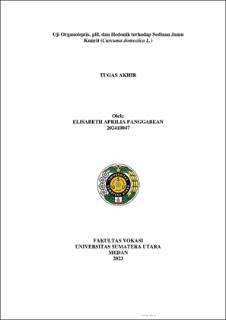| dc.description.abstract | Background: Turmeric (Curcuma domestica L.) is a biopharmaceutical plant that
is often found in Indonesia. Turmeric production in Indonesia reached I 84 82
thousand tons. The contents of turmeric that are often found are curcumin
( diferuoylmethane ), essential oils, curcuminoids, zingeberen, sesquiterpenes.
Turmeric is very popular with Indonesian people. Apart from being a kitchen spice,
it is also used as a natural ingredient in traditional medicine.
Objective: This research aims to determine the pH of Turmeric, determine the
organoleptic properties of the plant/traditional medicine Turmeric, and Hedonic
Test.
Method: Testing of turmeric herbal medicine uses qualitative methods to check
organoleptics such as taste, aroma, texture and color as well as hedonic tests, and
uses quantitative tests to check pH
Results: The results obtained from Jamu Turmeric were the highest pH obtained
by Jamu Turmeric in the Padang Bulan area, which was 4 71 and the lowest was
4 08 In the Pasar Baru area, the highest pH was obtained, namely 4 22 and the
lowest pH in Pasar Barn was 3.49 In the Setia Budi area, the highest pH was
obtained at 4.54 and the lowest pH was obtained at 3.85. The results obtained for
the Oranoleptic Test on Turmeric Herbal Medicine in the Padang Bulan area
showed that the texture was I iquid and thickened with a change in color from yellow
to orange brown and the aroma of the spices became more pungent. In the Pasar
Baru area, it was found that the texture was slightly thick and became thicker with
a change in color from dark brown orange to dark brown orange and the aroma of
spices became more pungent. In the Setia Budi area, it was found that the texture
was thick and increasingly thick with a color change from dark brown to very dark
brown and an increasingly strong aroma of spices.
Conclusion: Tests carried out for Jamu Turmeric include pH testing obtained in the
Padang Bulan area of 4 71, in the Pasar Baru area 422, in the Setia Budi area of
4 71 In organoleptic testing, changes were obtained starting from a bright color or
continuing with the color of Jamu Turmeric in generally until it becomes dark in
color, the texture starts with liquid or unknown until after seven days of observation
the shape will become thick or even very thick, fo llowed by a change in smell
starting with typical spices which are not too strong until when left for a week or
for seven days Turmeric herbal medicine experiences a change in aroma or the
smell becomes very strong In the Hedonic Test, it was found that the number of
"Enough" voters in the Padang Bulan area was the highest at 60%, the number of
"Good and Enough" voters in the Pasar Baru area was the highest at 50%, and the
number of "Very Good and Tasty" voters in the Setia Budi area has the largest
number at 40%. | en_US |





